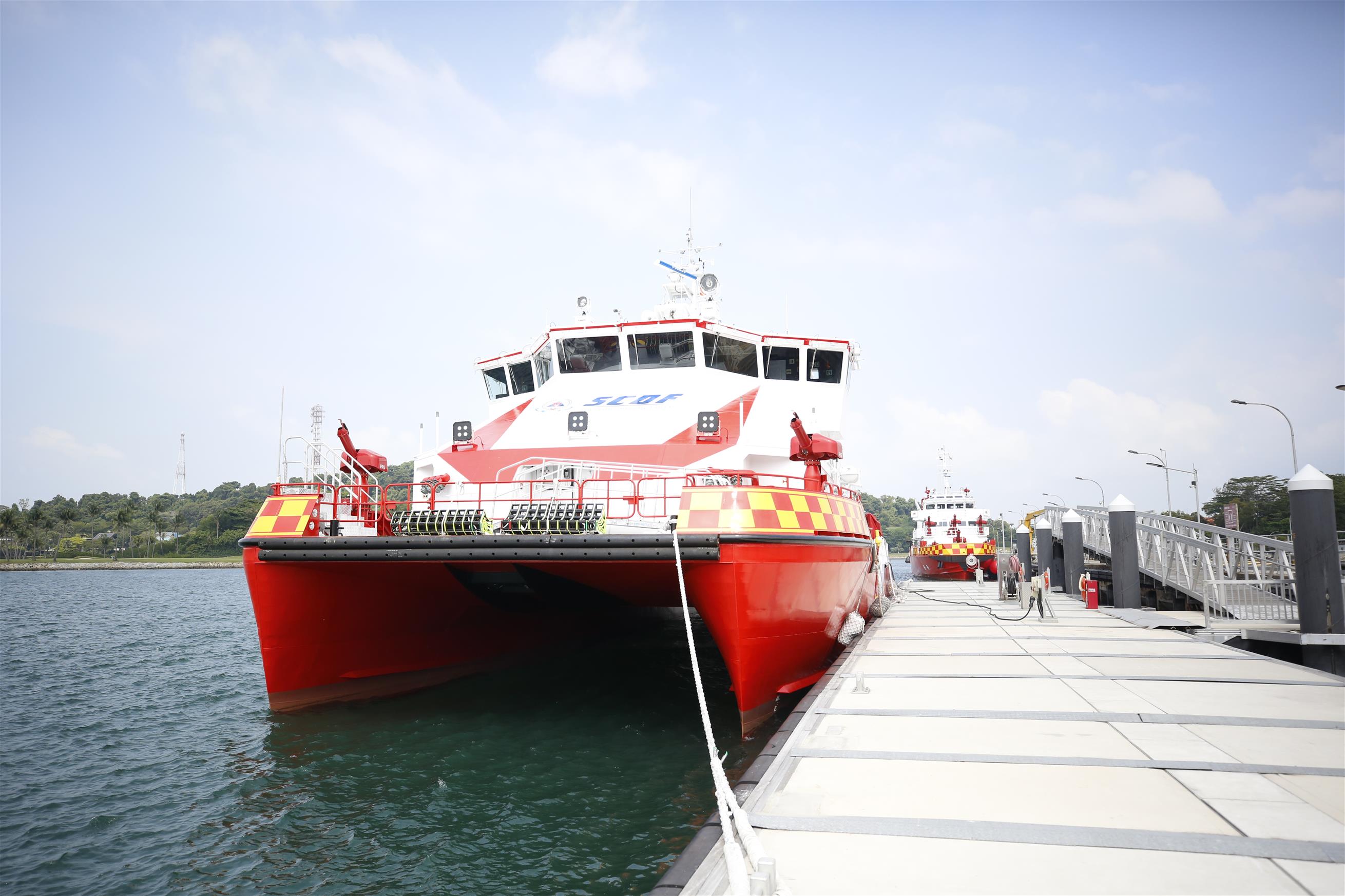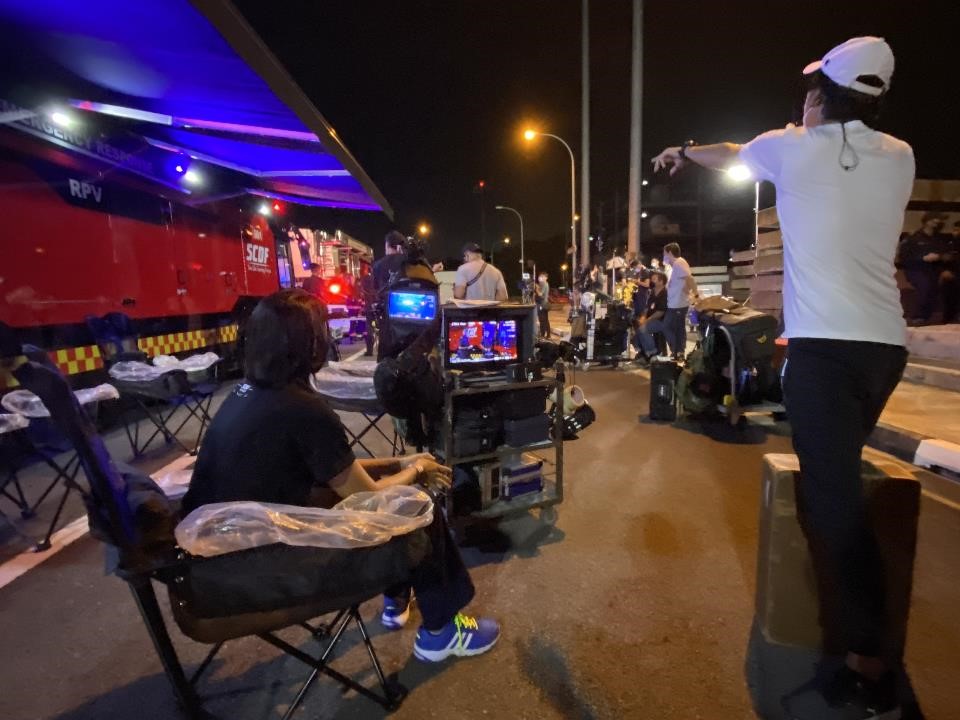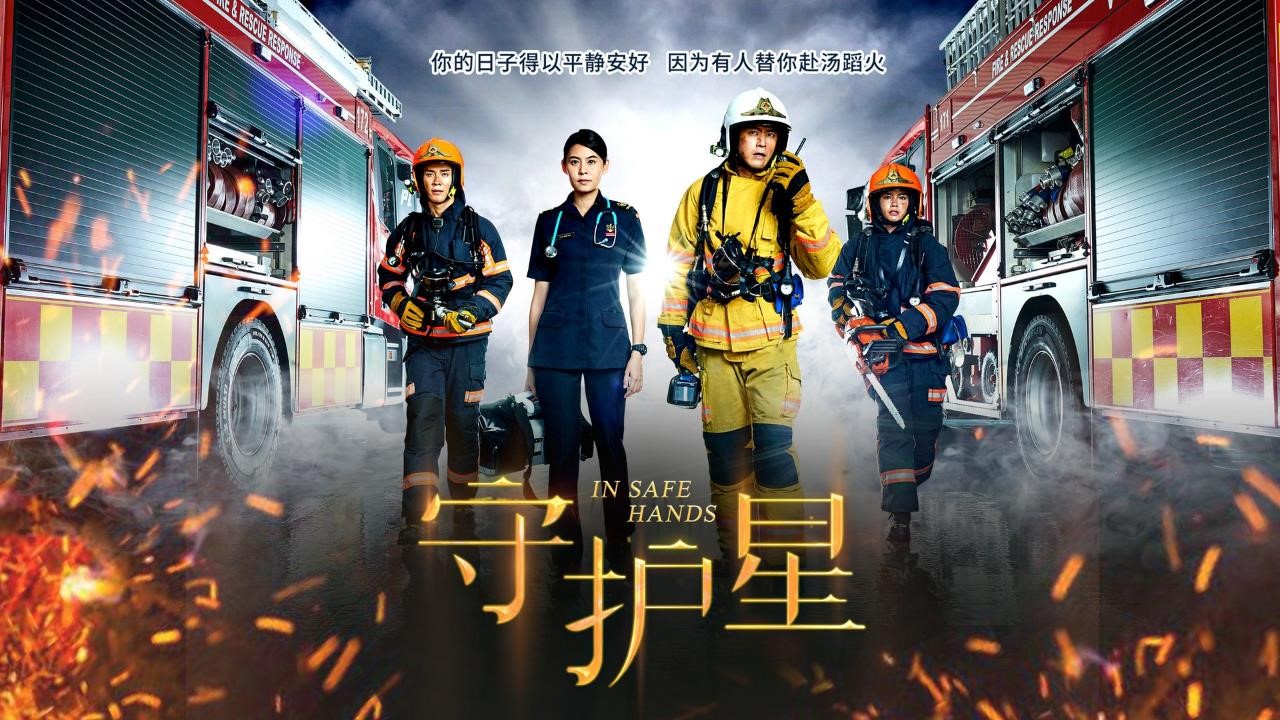On 1 April 2022, one of the world’s most powerful firefighting vessels, SCDF’s Heavy Fire Vessel (HFV), codenamed the Red Sailfish, put on a majestic display for guests and officers in attendance as SCDF Marine Division celebrated its 10th anniversary.
 The HFV in action at Brani Marine Fire Station
The HFV in action at Brani Marine Fire Station
Looking on with pride, SCDF Marine veterans Warrant Officer 1 (WO1) Cheong Kwong Hui, Warrant Officer 2 (WO2) Mohammed Firhin Bin Wahab and WO2 Mohamad Idros Bin Abubakar were among the many Marine Division officers present at this momentous event.
Rescue 995 spoke to these marine veterans in an exclusive interview on their experiences as the pioneers who set up SCDF’s Marine Division.
WO1 Cheong Kwong Hui
WO1 Cheong is a cross-trained Emergency Medical Technician (EMT) and a Marine Section Commander who holds an operational appointment as a Officer-On-Watch (OOW) at West Coast Marine Fire Station. Prior to joining the SCDF Marine Division, WO1 Cheong was serving his National Service (NS) with Jurong Fire Station before he decided to join the Maritime and Port Authority of Singapore (MPA) as a marine firefighter in May 2002. On 1 April 2012, when SCDF took over the marine firefighting and rescue responsibilities from MPA, WO1 Cheong opted to join SCDF as a Marine Specialist.
 WO1 Cheong Kwong Hui on the Rapid Response Fire Vessel (RFV)
WO1 Cheong Kwong Hui on the Rapid Response Fire Vessel (RFV)
Rescue 995: What were the most challenging moments for you during the initial years of Marine Division’s development?
WO1 Cheong: Immediately after taking over from MPA, we placed a lot of emphasis on training and drills. We needed to establish a strong foundation on the standards we wanted to set for future Marines. The training sessions pushed us to our mental and physical limits. Being a Marine Specialist, we are constantly tested on our skills and operational capabilities such as firefighting including challenging rescue operations involving high angle rescue techniques and confined space rescue operations. The training has prepared us to face any challenges at sea where the environment could be challenging and unpredictable at times.
Rescue 995: Can you share with us an incident you responded to which you still vividly remember till today?
WO1 Cheong: It was a peaceful night in June 2019, and we had just conducted our usual night routine at the fire station when we were activated to a case of fire onboard the container vessel which was anchored at Raffles reserved anchorage. Both Brani and West Coast Marine fire stations were activated for this incident and upon arrival at the location, there was already thick black smoke bellowing out from an affected container, which we were informed was loaded with power bank batteries.
We immediately sprang into action and climbed up the vessel’s cat ladder to about three-storeys to get near to the affected container so that we could direct our water jets onto the unaffected containers to shield them from the radiant heat. The firefighting was very intense but with the camaraderie and teamwork of both marine fire stations, the situation was quickly brought under control.
Other memorable incidents were the challenges faced when my Rota was activated to provide medical treatment and thereafter conduct a high angle height rescue to evacuate a casualty from a vessel, an Oil Products Tanker, which was anchored at Pulau Busing Tankstore Berth. There is a tremendous responsibility to ensure the safety of the casualty and the rescuer while a rescue operation is being conducted. There is no room for error, and we have to conduct each firefighting and rescue operation to perfection.
Rescue 995: Marine firefighting and rescue operations are different from land-based operations – What are the qualities a Marine specialist should have in order to carry out a marine firefighting and rescue operation well?
WO1 Cheong: Passion is key. Passion is the fuel that keeps me going in my career. It pushes me to constantly seek improvement and to always upgrade and equip myself with new skills and knowledge. This enables me to always be at my best and ready to respond to any incident that I am activated for.
WO2 Mohammed Firhin Bin Wahab
WO2 Mohammed Firhin is a Deputy Rota Commander (DRC) from West Coast Marine Fire Station. He began his stint in SCDF as an NSF in 2005 and was subsequently posted to Woodlands Fire Station as a Section Commander. In 2006, WO2 Mohammed Firhin decided to sign on with the SCDF and had remained at Woodlands Fire Station until he was posted to West Coast Marine Fire Station on 1 April 2012.
 WO2 Mohammed Firhin Bin Wahab
WO2 Mohammed Firhin Bin Wahab
Rescue 995: What was it like to be posted to the Marine Division on the first day of its establishment?
WO2 Mohammed Firhin: It came as a surprise to me because back then, one had to be recommended for the role as a marine specialist. I was asked to report to the marine fire station on 1 April which I initially thought was an April Fool’s joke, but I soon realised that it was for real. [laughs]
When we first took over the marine firefighting and rescue responsibility from MPA, I was appointed as a member of the renovation project team of West Coast Marine Fire Station. The building was operationally ready, but it lacked facilities such as locker space, gym and an operational watch room. It took us a while to plan and manage the renovation works till its completion.
When we acquired the Rapid Response Fire Vessel (RFV), Red Swordfish, I was selected to be in the first batch of trainers. We attended various courses with vendors to learn the capabilities and functions of the vessel. These courses equipped us with a solid foundation to conduct RFV courses with other trainers.
We were a lean team back then that comprised of all career officers with no Full-time National Servicemen (NSF) to assist us in our operational and administrative duties. Despite this, we managed to develop and build a system to operate a marine fire station. In my opinion, that was the toughest challenge I could recall.
Rescue 995: In comparison with the past, what do you think were the differences between what we see and know about the Marine Division then and today?
WO2 Mohammed Firhin: SCDF Marine Division has matured over the years, progressed from having only two firefighting vessels to a current fleet of six vessels with advanced capabilities. For the past ten years, I can proudly say that there has been a lot of technological enhancements, innovation and progression within our Marine Division.
Rescue 995: How has technology and innovation played a role in modernising Marine Division’s capabilities as compared to the capabilities we had when we took over the marine firefighting and rescue responsibility in April 2012?
WO2 Mohammed Firhin: Since the day our Marine Division became operational, modern technologies have been gradually introduced in our fleet of vessels. Initially, we had to climb back and forth between the wheelhouse and engine room to operate the firefighting systems onboard the older Marine Fire Vessel (MFV). The present state-of-the-art firefighting vessels has integrated firefighting operation control panels within the wheelhouse.
Our Marine Division is embarking on the next phase of development, the use of unmanned technologies which will broaden our scope of marine operations. I am proud to be part of the Marine Division as we continuously progress to integrate technology to enhance the safety within Singapore waters for the future.
 WO2 Mohammed Firhin starting up the Electronic Chart Display Information System (ECDIS) on board a vessel.
WO2 Mohammed Firhin starting up the Electronic Chart Display Information System (ECDIS) on board a vessel.
Rescue 995: Tell us about one major firefighting and/or rescue incident that you still vividly remember and how did the incident changed or challenged the way you view your profession as a marine firefighter?
WO2 Mohammed Firhin: I was responding to my first fire incident shortly after my posting to West Coast Marine Fire Station in 2012. We were responding to an emergency call at Pulau Tekong. I was on board a Marine Fire Vessel and when we were neared the incident site, we realised that there was no landing point for our MFV to berth. Subsequently, we deployed a dinghy to attempt laying hoses from the sea to the shore for the land-based firefighting operation. However, strong winds and the sea condition were pulling the hoses away and we had to use more hoses to fight the fire. It was a tug-of-war with the environment. This exhausting experience taught us a very important lesson on how we should be prepared for unforeseen weather conditions out at sea and this subsequently shaped our Operating Procedure for future sea operations.
WO2 Mohamad Idros Bin Abubakar
WO2 Mohamad Idros is an Executive Officer at Brani Marine Fire Station. He started his SCDF career as an ERS at Ang Mo Kio Fire Station in 2006, after completing his Full-time National Service as a Section Commander at Sengkang Fire Station. WO2 Mohamad Idros joined the Marine Division in 2014 and was posted to Brani Marine Fire Station as a Marine Section Commander before he was appointed as an Executive Officer in 2020. A Marine Executive officer is a leadership position in a Rota, who provides guidance to other Marine Specialists. This officer will also assist the Rota Commander (RC) and will work alongside the Deputy Rota Commander (DRC) during each duty.
 WO2 Mohamad Idros Bin Abubakar with the Red Sailfish at Brani Marine Fire Station
WO2 Mohamad Idros Bin Abubakar with the Red Sailfish at Brani Marine Fire Station
Rescue 995: What motivated you to join the Marine Division?
WO2 Mohamad Idros: When I first learnt that Marine Division was established, it piqued my interest to join the unit and back then, I was looking for new challenges in my career.
Rescue 995: When you were posted to Brani Marine Fire Station back in 2014, what were the challenges you and the team had to go through during this early and crucial development phase of the station? What was done to overcome the challenges, and how did pioneers like you developed a system to run the fire station the way it is being run today?
WO2 Mohamad Idros: As Brani Marine Fire Station was newly established at that time, we had to develop a specialised marine training manual. Called the Basic Task Manual (BTM), it comprised all the basic requirements of operational knowledge and skills of firemanship. Creating the BTM for marine firefighting was not an easy task and in the process, we had to seek advice from our Home Team partner, the Police Coast Guard (PCG), where we learned the rules of sea navigation, which is known as the Rules of the Road (ROR).
I also remembered that when we took over the two firefighting vessels from MPA, we had to rely on contracted sea captains to navigate the vessels during operations and exercises. This was an interim measure to allow us time to put in place a plan to train our marine officers to helm our vessels. The course to prepare us to self-helm our own vessels was intensive, and we had to undergo strenuous training such as clocking six months of maritime exposure and a seamanship test at the Maritime and Port Authority of Singapore (MPA) to be a qualified steersman.
As I was only an Engineering graduate and had no maritime experience, the learning curve was steep as I had to work very hard to acquire the nautical knowledge. Despite the initial challenges, my colleagues and trainers were very encouraging and that itself made the learning journey more enjoyable and meaningful.
 Firefighter 2 in action (the two firefighting vessels, Firefighter 1 and Firefighter 2, were decommissioned on 4 August 2021)
Firefighter 2 in action (the two firefighting vessels, Firefighter 1 and Firefighter 2, were decommissioned on 4 August 2021)
Rescue 995: When you were involved in the project group for SCDF’s Heavy Rescue Vessel, codenamed Red Manta in 2017, how did you manage to juggle work, part-time studies and being a new father at the same time?
WO2 Mohamad Idros: To be honest, I was surprised at how I was able to juggle between my career and personal life. It was indeed a challenging time for me. I took each day in its stride and focussed on giving my best effort to each task I undertook. My family and colleagues were also very encouraging, and my supervisor was also supportive of me pursuing my academic interest.
 The Heavy Rescue Vessel, also known as the Red Manta, is built for mass evacuations and rescue operations involving large number of casualties.
The Heavy Rescue Vessel, also known as the Red Manta, is built for mass evacuations and rescue operations involving large number of casualties.
Rescue 995: What do you envision or look forward to for Marine Division in the next 10 years?
WO2 Mohamad Idros: Marine Division has always been an innovative unit right from the start of its humble beginnings from just two vessels to our current fleet of six vessels of various sizes and capabilities. It would not be a surprise for me that in another 10 years, at least one-third of our future fleet could be operated remotely to make responding to complex marine operations safer and more efficient.





